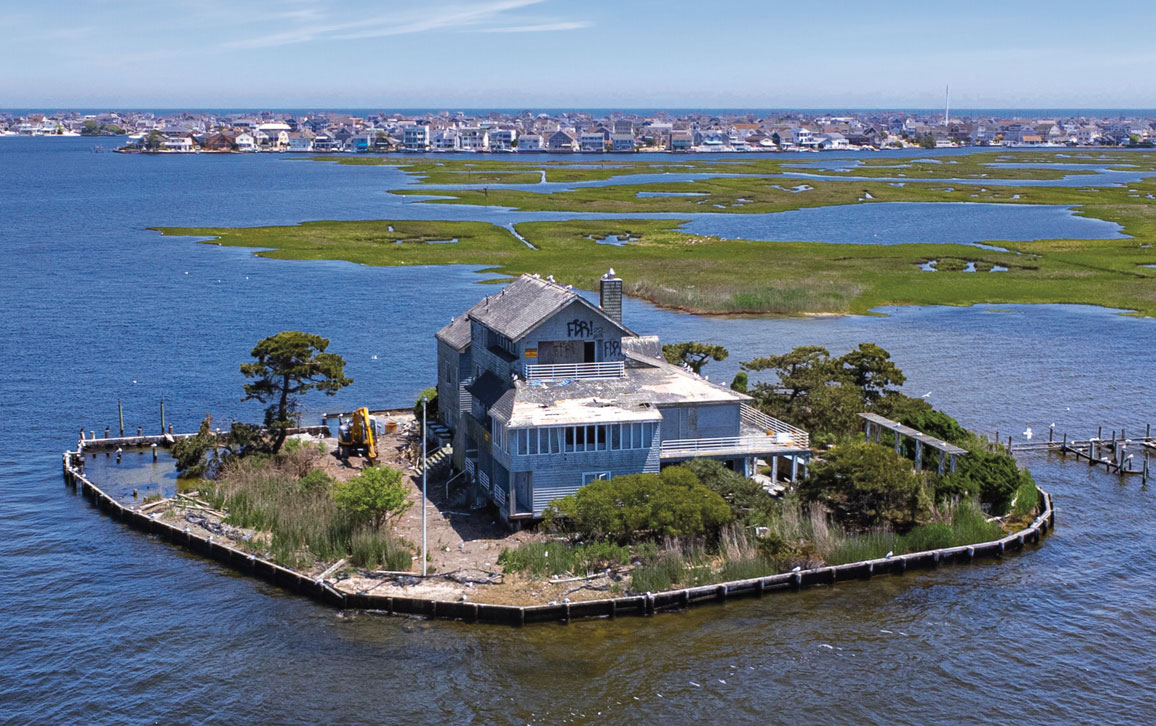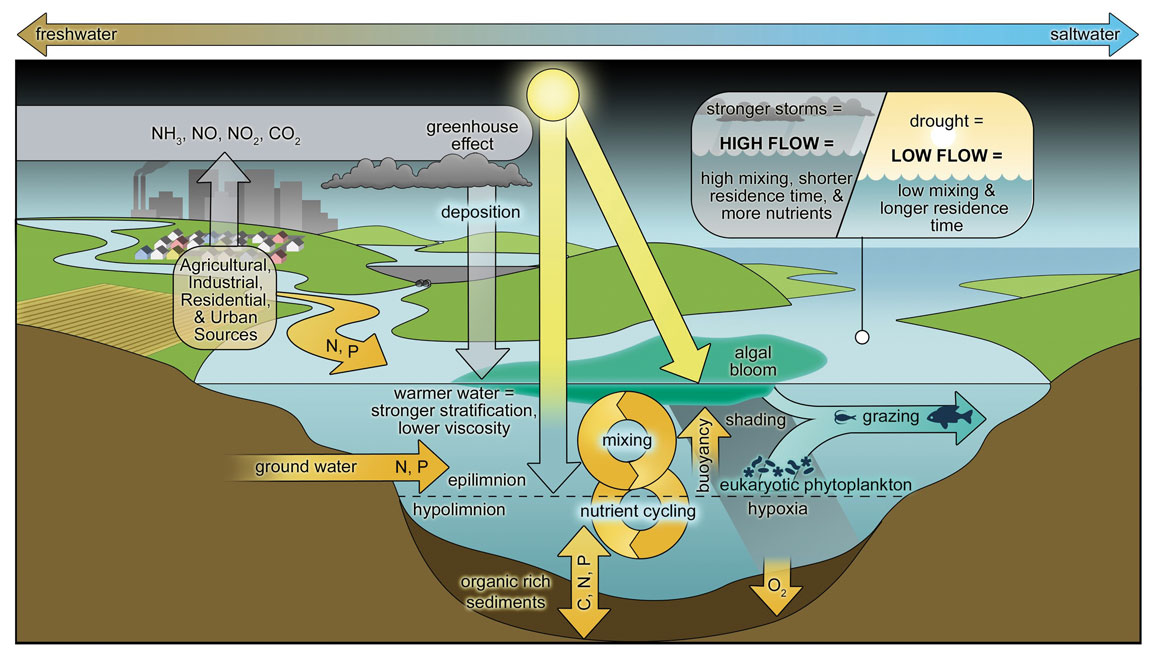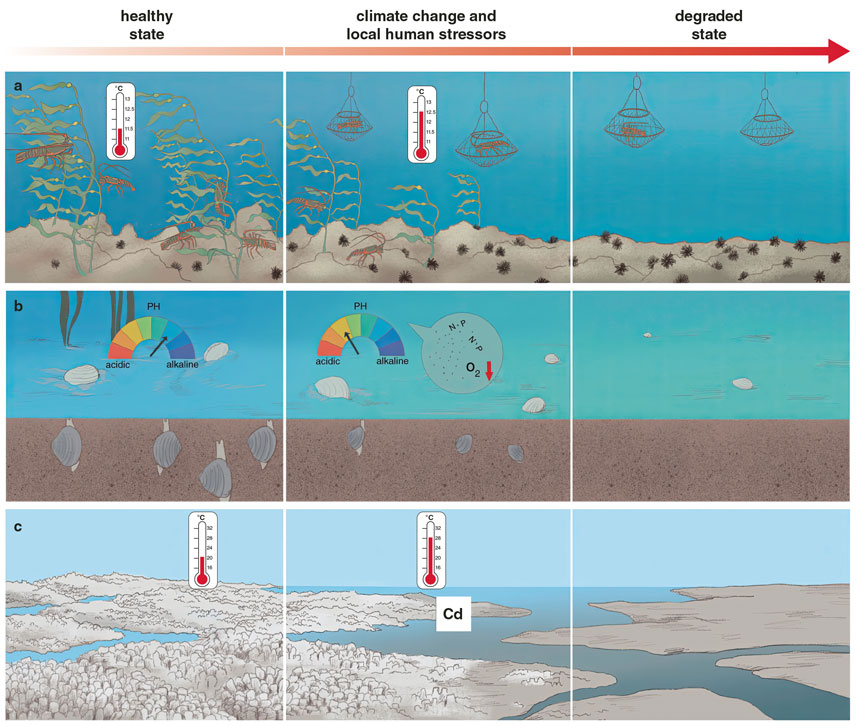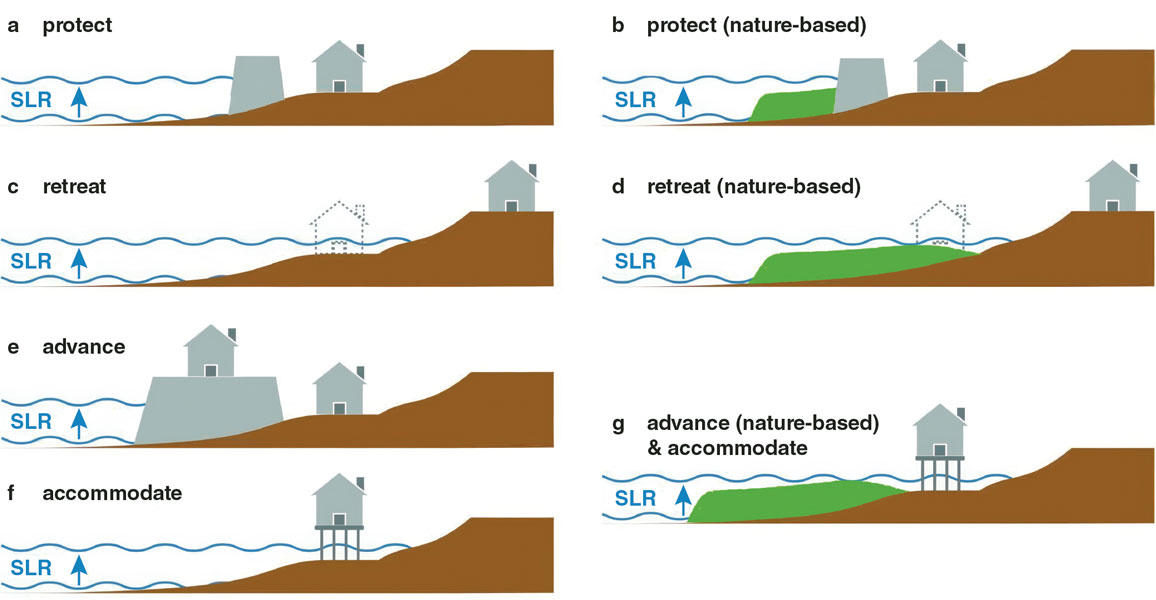Estuaries Face a Stormy Future
By Michael J. Kennish, Hans W. Paerl, Joseph R. Crosswell, Kenneth A. Moore
More frequent extreme-precipitation events, continued warming, and sea level rise pose significant threats to coastal ecologies.
More frequent extreme-precipitation events, continued warming, and sea level rise pose significant threats to coastal ecologies.

If we’re lucky, most of us never come face-to-face with true devastation. For the residents of New Jersey’s Barnegat Bay–Little Egg Harbor Estuary—no strangers to coastal storms—that luck ran out on October 29, 2012, when Superstorm Sandy struck. At more than 1,600 kilometers (1,000 miles) wide, it was the largest hurricane on record at the time. Advance warnings and the evacuation of thousands minimized the loss of life, but sustained hurricane-force winds of almost 130 kilometers per hour (80 miles per hour) and flood tides reaching four meters (13 feet) above mean low tide caused devastating damage to nearby homes and land areas on Island Beach and Long Beach Island, part of a barrier-island system extending for nearly 70 kilometers (43.5 miles). Sandy caused extensive damage to homes and land areas along the mainland as well.
The storm also changed my (Kennish’s) life. I had studied the estuary extensively as a coastal and marine scientist since 1973, and the devastation I saw as I walked along the shoreline in November 2012 was almost indescribable: On one whole block, homes were simply missing; on another, a house looked like a knife had sliced it lengthwise, opening a cutaway view to a pink bedroom set that could have been lifted right out of a TV soundstage. More than that, though, I could clearly see major altered components of the ecosystem, even from afar. I would later learn that Sandy had caused 38 deaths and almost $30 billion in damages in New Jersey, making it the costliest natural disaster in state history.
That was the day I shifted my focus to understanding the problems posed by climate change, including the increasingly intense storms that are damaging coastal regions. The impacts of climate change had struck home, and I wanted to know how such storms would affect the livability of human coastal communities, the sustainability of ecosystems, and the productivity of the resources that deliver goods and services to New Jerseyans.

Shorebeat.
Since that time, I have continued studying the estuarine system, but with a greater focus on human impacts on these fragile ecosystems. For example, I have studied the differences over time in species composition and vegetation structure across three segments of the Tuckerton Peninsula salt marsh system, a 2,000-hectare (7.7-square-mile) saltmarsh cordgrass (Spartina alterniflora) habitat along the southern margin of Barnegat Bay–Little Egg Harbor Estuary. Previous research has raised concerns that the accumulation of sediment and organic material in that system might not be enough to stop rising sea level from flooding and converting the marsh to open water.
On one whole block, homes were simply missing; on another, a house looked like a knife had sliced it lengthwise.
Although the impacts of sea level rise and shoreline erosion are most evident in the southern segment, the northern segment of the salt marsh system might in fact be in greater jeopardy due to its lower marsh surface elevations, which are likely due to parallel grid-ditching activities (an outdated marsh and wetland management and restoration technique to control mosquitoes by digging shallow ditches in a parallel grid pattern). Those ditches could enable rising seas to come into direct contact with the upper marsh plant community. It’s a prime example of how techniques intended to help can actually harm when we don’t account for the many interacting systems and forces at work. Differences such as those identified between the Tuckerton Peninsula segments have important management implications for other coastal marshes in the United States and elsewhere.
Below, my coauthors and I delve into the intricacies of estuaries in all of their complexity and vulnerability. If the term estuary is not familiar, prominent examples—Chesapeake Bay, San Francisco Bay, Puget Sound—are household names and share defining characteristics: All are partially enclosed transitional areas where fresh water from rivers meets salt water from oceans. Estuaries cover 1.1 million square kilometers (424,700 square miles) of the globe and more than 400,000 kilometers (250,000 miles) of coastline. The United States alone hosts more than 900 estuaries, with 80 to 90 percent of them lying along the Atlantic and Gulf Coasts.
Estuaries are renowned for their distinctive habitats and for the many freshwater and marine plants and animals they support, from the marshes and migratory birds of Chesapeake Bay to the Bengal tigers of the Sundarbans, where the delta of the Ganges, Brahmaputra, and Meghna Rivers meets the Bay of Bengal. They are places where elements such as carbon, nitrogen, phosphorus, and oxygen cycle from soil, air, and sea through living organisms, producing stunning biodiversity, splendid natural beauty, and notable pollution-filtering capacity. Their wealth of nutrients gives estuaries a markedly high productivity of biomass (organic material) that supports their rich food webs, often more so than many terrestrial and aquatic ecosystems. But, like any delicately balanced system, they are also extremely sensitive to environmental shifts, including those brought on by climate change.

Adapted from Paerl et al., 2014.
A little more than 480 kilometers (300 miles) south-southeast of my home bays, there are estuaries that bear the brunt of even more hurricanes than New Jersey. Continuous rainfall records for coastal North Carolina since 1898 reveal a period of unprecedented storm events since the late 1990s. The coastal portion of the Tar Heel State has experienced 38 tropical cyclones in the past three decades, including floods of historic significance from hurricanes Floyd (1999), Matthew (2016), and Florence (2018).
Hans Paerl and his colleagues at the University of North Carolina at Chapel Hill have studied how these events have brought about major alterations in water quality, fishery habitat, and ecological conditions in the Albemarle-Pamlico Sound, the second-largest estuarine complex in the United States. They have found that, depending on conditions and flooding, such heavy storms account for more than 50 percent of annual loads of carbon and nutrients flushed into one major subsystem, the Neuse River Estuary, from both natural sources (such as soil erosion and downed and decomposing vegetation) and human ones (such as fertilizers, wastewater, and urban stormwater runoff).
Paerl has used data from the National Centers for Environmental Information to calculate cumulative losses to North Carolina exceeding $2 billion due to effects on fisheries, recreation, and tourism—not to mention even larger losses in crops, livestock, aquaculture, and managed forests—since the upsurge in tropical cyclones began in 1996. The negative effects on environmental health and biodiversity are harder to quantify but equally serious.
Perturbing a finely balanced collection of systems such as an estuary can have significant consequences across various scales of space and time, from impacts on the phytoplankton that are estuaries’ most important primary producers (organisms that convert inorganic carbon into organic carbon molecules such as glucose) to habitat degradation, which impairs estuaries’ functions as fish and shellfish nurseries and fishing grounds—key foundations of coastal economies.
In the short term, muddy, churned-up waters reduce light penetration, which can impede the growth and photosynthesis of seagrasses, microalgae, and macroalgae—sources of habitat, food, and oxygen. This turbidity worsens when nutrient-rich suspended sediments, sewage discharge, and agricultural runoff containing fertilizer and waste are discharged into estuaries, promoting algal blooms. The rapid proliferation of algae can include species that produce harmful toxins that can sicken and sometimes kill fish, marine mammals, and seabirds (the best-known example being the red tide produced by single-celled algae called dinoflagellates).
If the term estuary is not familiar, many examples—Chesapeake Bay, San Francisco Bay, Puget Sound—are household names.
Such toxins also can bioaccumulate in shellfish, such as mussels, clams, oysters, and scallops, potentially harming humans who consume them and, by extension, the fishing industry. Coastal ocean shellfish are already experiencing stress due to acidification as the Earth’s oceans absorb more CO₂ from the atmosphere. Moreover, many such species go through planktonic larval stages that are more sensitive to water quality conditions than are their adult forms.
As global temperatures rise, the biogeographic ranges of some species in estuaries and coastal marine waters are extending to higher latitudes and deeper waters. These include many benthic invertebrate species (bottom-dwelling worms, mollusks, crustaceans, and, to a lesser degree, echinoderms such as sea stars and sea cucumbers, all of which play vital roles in nutrient cycling, sediment stability, and food webs). Other species’ ranges are contracting at lower latitudes.
All of these impacts happen in unison and can build on each other. In addition to disrupting food webs, algal blooms can deplete oxygen: At night or during cloudy days, they can use up more oxygen than their photosynthetic processes replace. When they die, they settle on the estuarine floor and decompose. This decay, in turn, releases nutrients such as nitrogen and phosphorus, which promote further algae growth, as well as CO₂, which can intensify acidification. The bacteria that colonize and break down their remains consume dissolved oxygen from surrounding waters, causing the mortality of marine life such as shellfish. Indeed, Paerl’s research has found extensive bottom-water hypoxia (life-threatening reductions in oxygen) in such areas that has impacted North Carolina’s Neuse River Estuary and downstream Pamlico Sound following major hurricanes, including Floyd and Florence.
Harmful algal blooms will only worsen as temperatures climb— speeding metabolic cycles and growth rates, lengthening growing seasons, and creating conditions more conducive to toxic species such as cyanobacteria (blue-green algae) as well as other species that thrive in warm, nutrient-rich waters.
Many of the least-desirable species will also benefit from more intense and longer-lasting thermal stratifications—partitioning of water bodies into layers with different temperatures and densities. Stratification occurs for a variety of reasons: Warmer weather heats surface waters, reducing their density; influxes from warm streams sit on top of colder, denser, saltier sea water; and precipitation dilutes surface water salinity, changes the topmost layer’s temperature, and increases land runoff. The effects of precipitation seem likely to increase as heavy rainfalls become more common under climate change.
The stronger the density stratification, the less likely an estuary’s layers will mix. This inertia benefits algal blooms and worsens hypoxia deeper down. Meanwhile, species also must cope with differences in nutrient availability and with salinity regimes to which they might be maladapted. Worse, these new extremes will exert their greatest pressures during the summer months. Summer is already a time of great stress for temperate estuaries. For example, the metabolisms of fish and other ectothermic (cold-blooded) animals, which are tied to water temperatures, speed up, and many species become more active and engage in breeding—all of which means they need more oxygen. But warmer waters and intensified thermal and density stratification make oxygen harder to come by. Summer is also the season of greatest disturbance by humans.
Algal blooms are among the most visible and most widely reported climate-change-induced water quality impacts facing estuaries. But they are merely an ominous symptom of the many factors at play (hypoxia, toxins, stratification, and salinity changes, for example) and how those factors interact in complex and nonlinear ways.
We could just as readily have focused on the diverse array of invertebrate organisms that live on or within the sediment at the bottom of estuaries, from mollusks to crustaceans, and from sponges to sea stars. Based on decades of research, Jeffrey S. Levinton and his colleagues in the Department of Ecology and Evolution at Stony Brook University in New York have documented that these estuarine benthic invertebrate communities consist of dynamic and highly variable species that are responsive to short-term and seasonal changes in environmental conditions, which control their patterns of distribution, reproduction, recruitment, and mortality.
Estuaries cover 1.1 million square kilometers of the globe and more than 400,000 kilometers of coastline.
Or we could cite the work of Alan K. Whitfield who, with his colleagues at the South African Institute for Aquatic Biodiversity, has shown how climate-change-induced variations in physical and chemical environmental factors can significantly influence the abundance and distribution of estuarine fishes, which are already stressed by anthropogenic drivers such as overfishing, pollution, habitat degradation, and altered river flow.
The examples go on. Looking skyward and along the shore, one can see the impacts of climate change—and more direct anthropogenic effects—on coastal birds as well. Joanna Burger of Rutgers University in New Jersey reports increasing alteration and loss of avian nesting and foraging habitats in the coastal zone since the 1970s due to higher air and water temperatures, sea level rise, episodic rainfall events, variable food resources, and other factors. As a result, significant shifts have occurred in the nesting, roosting, wintering, and migration patterns of birds in coastal and estuarine habitats.

Google Earth (inset map: Department of Environmental Protection/NJ.gov).
Increasing temperature is an important driver of changes affecting coastal birds, but so too are human modifications of the coast. Seawalls, revetments, bulkheads, and other hard shoreline structures decrease habitat continuity for breeding and migrating birds. In addition, the hard structures create physical barriers to avian use. Meanwhile, habitat loss and disturbances from climate change and human activities have destroyed suitable habitat for foraging and nesting.
All of these examples illustrate the diverse range of harms stemming, both singly and synergistically, from the natural and human forces at play.

Figure reprinted from He, Q and B. Silliman, Current Biology 20:R1021–1035, with permission of Elsevier.
Plants in estuaries are threatened in much the same way as animals. The diverse coastal vegetated habitats (such as marshes, mangroves, and seagrasses) that spread from the tidal fresh water to salt water regions of estuaries provide key services, including protection of coastlines, sequestration of greenhouse gases, water storage, support of coastal food webs, filtration of land-derived nutrients and contaminants, and habitats for estuarine and marine organisms. But, once gone, these important plant communities may undergo only a very limited natural recovery.
Consider, for example, the effects of increased storminess. High storm surges and bigger waves from more intense storms can damage and uproot mangroves, salt marsh plants, and vital seagrasses, while eroding, scouring, or redistributing the very sediments in which they grow. These factors limit the effectiveness of efforts to mitigate coastal nutrient pollution and even reduce potential for restoration.
Because seagrasses are important stabilizing components of coastal systems, losing them can result in changes in the states of local ecosystems that inhibit their regrowth and recovery. For example, more than 60 percent of eelgrass meadows along the northwest Swedish coast have been lost since the 1980s. Work in the area by Per-Olav Moksnes of the University of Gothenburg and colleagues has shown that the failure of eelgrasses to recover is due to a large-scale shift to conditions dominated by dense, layered algae accumulations called algal mats, which block light and smother eelgrass, and to a persistent murkiness from suspended sediment.
Significant shifts have occurred in the nesting, roosting, wintering, and migrating patterns of the birds in coastal and estuarine habitats.
A healthy eelgrass meadow could help stop sediments from resuspending and keep algae in check by absorbing nutrients, generating oxygen, and providing habitat for algae-grazing fish and invertebrates. However, in too many cases eelgrass regrowth cannot get a toehold, even with outside help. Realities such as these, when combined with increases in extreme precipitation patterns and warming air and water, exemplify how storms are altering the abundance and distribution of coastal vegetation.
Meanwhile, invasive species are increasing in climatically and anthropogenically perturbed habitats, reducing local endemism (the presence of species found only in a certain place). As emphasized by Edwin Grosholz of the University of California, Davis, estuaries are among the most highly invaded ecosystems on Earth. These invading species can dramatically increase in abundance, disrupt native communities, perturb the structure and function of estuarine ecosystems, and introduce new pathogens and parasites, potentially threatening other estuarine organisms and ultimately humans.
Finally, among the most damaging effects of climate change on natural and built communities are those caused by sea level rise, which has increased significantly over the past several decades. NASA satellite radar altimetry measurements (which measure the vertical shape and height of the ocean’s surface with pulses of radio waves) indicate that sea level rise has increased at a rate of 3.9 millimeters per year (more than one-eighth of an inch) over the last decade. Accelerating sea level rise is contributing to greater frequency and severity of beach erosion, inundation, flooding, and other extreme effects.
In short, we have entered a new climatic regime characterized by more frequent extreme precipitation events, sea level rise, and continuous warming, with major ramifications for water quality, resources, and the livability of our coastal regions, where more than 40 percent of people around the world reside. How can we adapt?
Given the array of complex factors at play, it is no surprise that coastal managers now find themselves facing a formidable and unprecedented task as they struggle to mitigate climate impacts and build resilient communities.
From a management perspective, these effects will bring with them a slew of impacts on coastal infrastructure. Ecosystem services such as seafood resources and safety will decline, reducing food security, diminishing tourism and recreation, and intensifying other socioeconomic pressures, even as the costs of mitigation, adaptation, and resilience programs rise.

Modified after Oppenheimer et al., IPCC Special Report on the Ocean and Cryosphere in a Changing Climate, 2019.
At higher levels, mitigation begins with administrative leaders working collectively to reduce greenhouse gas emissions by facilitating the transition to renewable energy and modifying shipping and transportation, fisheries, and agricultural systems. Donald F. Boesch of the University of Maryland Center for Environmental Science in Annapolis says acting on the climate crisis requires an appreciation of the socioeconomic context, decision-making framework, and management options available.
Meanwhile, for coastal managers, efforts focused on mitigating climate impacts and enhancing estuarine adaptation and resilience should be as diverse as the systems they address. Along with the restoration of ecosystems for greater carbon retention and sequestration (for example, through enhancing plant communities that capture and store significant amounts of carbon, such as seagrasses, mangroves, and salt marshes), those efforts should include the planting and restoration of dunes. Living shorelines of plants, sand, and rocks can reduce erosion and establish habitats, as can oyster reefs, which also can blunt wave energy and improve water quality through their filtering activities.
As we adapt to those effects of climate change that we cannot stop or stall, we must also adopt a more sustainable approach within the built environment. Examples include setback zones, as well as flood barriers and sea walls that protect against storm surges and flooding. The latter must minimize ecological disruptions, however, and balance hard constructions against softer, less expensive alternatives such as restoration initiatives that promote wetland creation and expansion of coastal vegetated habitat. Smarter development, better management of nutrients and pollutants, climate monitoring systems, and greener infrastructures (such as riparian buffers and constructed wetlands) that control stormwater runoff and reduce flooding can provide important tools for adaptive management. But they must work in concert with policies and regulations backed by public awareness and incentives aimed at conservation.
Management efforts focused on mitigating climate impacts and enhancing estuarine adaptation and resilience should be as diverse as the systems they address.
No single management approach addresses the entire suite of climate change and direct anthropogenic impacts currently under way. Indeed, management concerns for improving estuarine conditions are typically site-specific and focused on the most serious impacts driven by local anthropogenic and natural stressors, such as excessive nutrient inputs from coastal watersheds driving eutrophication and declining water quality.
But we as a species cannot take so narrow a view. As Jennifer K. O’Leary of the Wildlife Conservation Society in Mombasa, Kenya, and her colleagues observe, this wider view requires evaluating critical site-specific environmental threats while also understanding that a reduction of global greenhouse gas emissions will be necessary for the sustainability of estuaries worldwide.
Michael Elliott of the University of Hull in England and his colleagues have demonstrated the value of a comprehensive approach to coastal management—one that maintains healthy, productive, and resilient ecosystems while also promoting their environmental, social, and economic sustainability. Ecosystem-based approaches seek to ensure that management processes sustain ecosystem services, societal goods, and benefits (including food production, coastal protection, disturbance regulation, erosion control, pollution sequestration, water quality control, and habitat-fishery linkages).
With escalating human population growth, development, and multiple human activities in coastal areas, it is becoming increasingly difficult to manage for the sustainability of estuarine ecosystems and their resources without considering both societal and ecological elements, particularly as climate change effects intensify.
Implementing the climate mitigation, adaptation, and resilience measures required to improve conditions of coastal environments and estuaries will take a concerted effort by multiple sectors of society. But the many places already impacted by climate change-driven disruptions, including Barnegat Bay–Little Egg Harbor Estuary, cannot wait for a political sea change.
I (Kennish) still work in some of the many bodies of water across New Jersey and other coastal places where Superstorm Sandy caused such acute damage—altering water quality, estuarine-bottom habitat, salt marshes, biotic communities, and shore towns. In Barnegat Bay–Little Egg Harbor Estuary, massive over-wash of sediments from the bordering barrier islands and nearshore ocean floor had buried seagrass beds and other bottom habitat that supported biotic communities. These events caused considerable mortality and had marked impacts on the abundance and distribution of seagrass beds that serve as vital habitat. Subsequent restoration, including sediment and debris removal, improved water quality and biotic conditions within 12 to 24 months following the storm, but more needs to be done.
Though these water bodies remain deeply important to me, they are mere reflections of larger issues. Here, as in so many places, rising water levels have been inundating salt marshes, enhancing erosion, and reducing surface area. Flooding is increasing in built communities of the coastal watershed. Biotic communities are changing. The past decade or more has seen an increase in harmful algal blooms, low-dissolved-oxygen events, fishery declines, and a reduction of areal cover and biomass of seagrass beds in the estuary. Rapid increases in the abundance of sea nettles (Chrysaora quinquecirrha) and bay nettles (Chrysaora chesapeakei) are affecting food webs via consumption of zooplankton and ctenophores (also called comb jellies). And there appears to be shifting distributions among fish and shellfish in estuarine and coastal marine waters that could affect recreational and commercial fishing interests and markets.
Meanwhile, global emissions of carbon dioxide continue to grow; indeed, they reached record highs during 2023. Unless nations and corporations significantly reduce these outputs in the years ahead, my coauthors and I must continue to harbor serious concerns about the future sustainability and viability of estuarine and marine ecosystems as we have come to know and value them.
This article is adapted from Climate Change and Estuaries (CRC Press, 2024).
Click "American Scientist" to access home page
American Scientist Comments and Discussion
To discuss our articles or comment on them, please share them and tag American Scientist on social media platforms. Here are links to our profiles on Twitter, Facebook, and LinkedIn.
If we re-share your post, we will moderate comments/discussion following our comments policy.